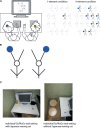Sharing Different Reference Frames: How Stimulus Setup and Task Setup Shape Egocentric and Allocentric Simon Effects
- PMID: 30555364
- PMCID: PMC6284048
- DOI: 10.3389/fpsyg.2018.02063
Sharing Different Reference Frames: How Stimulus Setup and Task Setup Shape Egocentric and Allocentric Simon Effects
Abstract
Different reference frames are used in daily life in order to structure the environment. The two-choice Simon task setting has been used to investigate how task-irrelevant spatial information influences human cognitive control. In recent studies, a Go/NoGo Simon task setting was used in order to divide the Simon task between a pair of participants. Yet, not only a human co-actor, but also even an attention-grabbing object can provide sufficient reference in order to reintroduce a Simon effect (SE) indicating cognitive conflict in Go/NoGo task settings. Interestingly, the SE could only occur when a reference point outside of the stimulus setup was available. The current studies exploited the dependency between different spatial reference frames (egocentric and allocentric) offered by the stimulus setup itself and the task setup (individual vs. joint Go/NoGot task setting). Two studies (Experiments 1 and 2) were carried out along with a human co-actor. Experiment 3 used an attention-grabbing object instead. The egocentric and allocentric SEs triggered by different features of the stimulus setup (global vs. local) were modulated by the task setup. When interacting with a human co-actor, an egocentric SE was found for global features of the stimulus setup (i.e., stimulus position on the screen). In contrast, an allocentric SE was yielded in the individual task setup illustrating the relevance of more local features of the stimulus setup (i.e., the manikin's ball position). Results point toward salience shifts between different spatial reference frames depending on the nature of the task setup.
Keywords: Simon effect; allocentric frame of reference; egocentric frame of reference; joint action; task sharing.
Figures





Similar articles
-
The Simon effect based on the egocentric and allocentric reference frame.Atten Percept Psychophys. 2016 Feb;78(2):427-36. doi: 10.3758/s13414-015-1032-0. Atten Percept Psychophys. 2016. PMID: 26603042
-
The Simon Effect Based on Allocentric and Egocentric Reference Frame: Common and Specific Neural Correlates.Sci Rep. 2019 Sep 24;9(1):13727. doi: 10.1038/s41598-019-49990-5. Sci Rep. 2019. PMID: 31551429 Free PMC article.
-
The Multimodal Go-Nogo Simon Effect: Signifying the Relevance of Stimulus Features in the Go-Nogo Simon Paradigm Impacts Event Representations and Task Performance.Front Psychol. 2018 Oct 25;9:2011. doi: 10.3389/fpsyg.2018.02011. eCollection 2018. Front Psychol. 2018. PMID: 30410459 Free PMC article.
-
Are All Spatial Reference Frames Egocentric? Reinterpreting Evidence for Allocentric, Object-Centered, or World-Centered Reference Frames.Front Hum Neurosci. 2015 Dec 9;9:648. doi: 10.3389/fnhum.2015.00648. eCollection 2015. Front Hum Neurosci. 2015. PMID: 26696861 Free PMC article. Review.
-
The joint Simon effect: a review and theoretical integration.Front Psychol. 2014 Sep 5;5:974. doi: 10.3389/fpsyg.2014.00974. eCollection 2014. Front Psychol. 2014. PMID: 25249991 Free PMC article. Review.
Cited by
-
What Simon "knows" about cultural differences: The influence of cultural orientation and traffic directionality on spatial compatibility effects.Mem Cognit. 2023 Apr;51(3):526-542. doi: 10.3758/s13421-022-01360-9. Epub 2022 Sep 30. Mem Cognit. 2023. PMID: 36180770 Free PMC article.
-
Spatial-numerical associations in the presence of an avatar.Psychol Res. 2021 Oct;85(7):2588-2598. doi: 10.1007/s00426-020-01424-y. Epub 2020 Oct 7. Psychol Res. 2021. PMID: 33026539 Free PMC article.
References
-
- Ansorge U., Wuhr P. (2004). A response-discrimination account of the Simon effect. J. Exp. Psychol. Hum. Percept. Perform. 30 365–377. - PubMed
-
- Aron A., Aron E. N., Smollan D. (1992). Inclusion of other in the self scale and the structure of interpersonal closeness. J. Pers. Soc. Psychol. 63 596–612.
-
- Craft J. L., Simon J. R. (1970). Processing symbolic information from a visual display: interference from an irrelevant directional cue. J. Exp. Psychol. 83 415–420. - PubMed
LinkOut - more resources
Full Text Sources
Molecular Biology Databases

